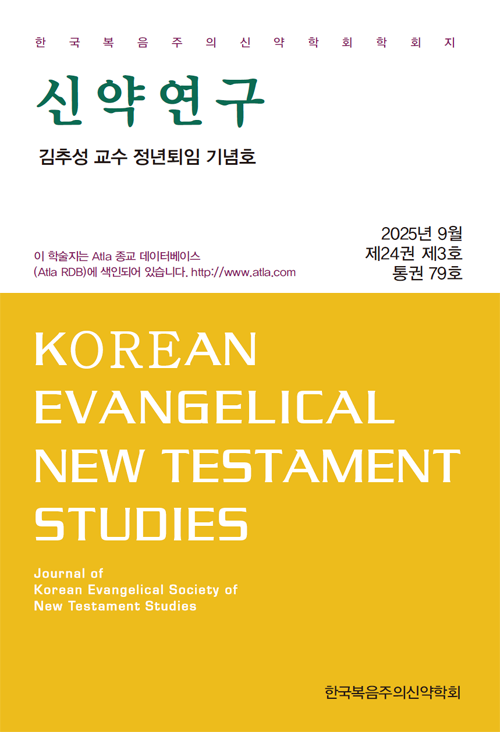- 영문명
- A Discourse Analysis of 2 Thessalonians 3:17 and a Critical Reassessment of the Argument against Pauline Authorship
- 발행기관
- 한국복음주의신약학회
- 저자명
- 김성민(Sungmin Kim)
- 간행물 정보
- 『신약연구』제24권 제3호, 365~403쪽, 전체 39쪽
- 주제분류
- 인문학 > 종교학
- 파일형태
- 발행일자
- 2025.09.30
7,480원
구매일시로부터 72시간 이내에 다운로드 가능합니다.
이 학술논문 정보는 (주)교보문고와 각 발행기관 사이에 저작물 이용 계약이 체결된 것으로, 교보문고를 통해 제공되고 있습니다.

국문 초록
데살로니가후서 3:17은 바울이 자신의 이름과 친필을 명시하는 구절로, 주로 ‘저자 인증’으로 해석되며, 데살로니가후서의 바울 저작부정을 주장하는 논의에서 핵심 논거이자 지속적인 논쟁의 대상이되어 왔다. 바울 저작을 부정하는 입장은 이를 후대 가명 저자의 바울 권위 차용으로, 긍정하는 입장은 바울의 이름으로 유포된 위조서신에 대한 바울의 대응으로 이해한다. 본 연구는 양측 해석이 공유하는 전제, 곧 3:17이 저자 진위성을 강조하는 장치라는 가정을 재평가한다. 연구의 목적은 이 구절의 기능을 면밀히 검토함으로써, 이를바울 저작 부정 논증의 핵심 근거로 전제해 온 해석의 타당성을 규명하는 데 있다. 이를 위해 3:17의 발화 주체 전환과 문법·정보 구조의상호작용을 정밀하게 분석하기에 적합한 신약 헬라어 담화 분석의주제화 분석(thematization analysis)과 행위 의미 체계(transitivity network)를 적용하였다. 문법 구조, 정보 배치, 인칭 전환, 동사상, 그리고 인접 구절인 3:18과의 연계 분석 결과, 본문은 저자 진위성강조 장치라기보다는 서신 종결부에서 바울이 수신자에게 직접 인사를 전하는 관계적 수행으로 이해된다. 이는 공동 저자 구조 속에서도바울의 주도적 위치와 관계적 개입이 두드러지게 드러나는 언어적수행이며, 또한 고대 서신 관행 속 정형적 인사 양식의 구현이다. 따라서 3:17을 저자 인증 수사로 해석하는 견해는 문법과 담화 기능을충분히 반영하지 못하며, 이를 바울 저작 부정의 근거로 삼아 온 기존 논증은 본문 분석에 비추어 설득력을 상실한다.
영문 초록
Second Thessalonians 3:17, in which Paul explicitly states his name and autograph, has often been interpreted as an “authentication device” and has served as both a central argument and a persistent point of debate in challenges to Pauline authorship. Those who deny Pauline authorship regard the verse as the appropriation of Paul’s authority by a later pseudonymous writer, while those who affirm Pauline authorship view it as Paul’s response to forged letters circulated in his name. This study reevaluates the shared assumption underlying both positions—namely, that 3:17 functions primarily as a marker of authorial authenticity. The purpose of the study is to examine the verse’s discourse function in detail and thereby reassess the validity of using it as a decisive basis for arguments against Pauline authorship. For this purpose, the analysis applies thematization analysis and a transitivity network, methods within New Testament discourse analysis particularly suited for examining the interaction of speaker shifts and grammatical and informational structures, to 3:17. Analysis of its grammatical structure, information arrangement, shifts in person, verbal aspect, and connection with the adjacent verse (3:18) shows that the verse is better understood not as a device of authorial authentication but as a relational-performative act in which Paul personally conveys greetings in the letter’s closing. This reading highlights Paul’s primary and representative role within a co-author framework and reflects the conventional closing practices of ancient letter writing. Consequently, interpretations that reduce 3:17 to a rhetorical signature of authentication fail to account for its grammatical and discourse functions, and arguments against Pauline authorship built upon this premise lose persuasive force in light of the present analysis.
목차
1. 서론
2. 데살로니가후서 3:17에 대한 기존 해석의 전제와 재검토
3. 분석을 위한 방법론적 접근
4. 데살로니가후서 3:17의 구조와 담화 기능 분석
5. 데살로니가후서 2:2와 3:17의 관계에 대한 추가적 소고
6. 결론
참고문헌
키워드
해당간행물 수록 논문
참고문헌
관련논문
인문학 > 종교학분야 BEST
- 인공지능 디지털교과서(AIDT) 도입의 문제점 및 개선 방안
- 생성형 AI 시대의 교육 패러다임 변화와 교사 역할의 재정립
- AI 시대, 대학생의 인성교육 현황과 시사점: 2개 대학의 인성교육 사례 분석
인문학 > 종교학분야 NEW
더보기최근 이용한 논문
교보eBook 첫 방문을 환영 합니다!

신규가입 혜택 지급이 완료 되었습니다.
바로 사용 가능한 교보e캐시 1,000원 (유효기간 7일)
지금 바로 교보eBook의 다양한 콘텐츠를 이용해 보세요!



